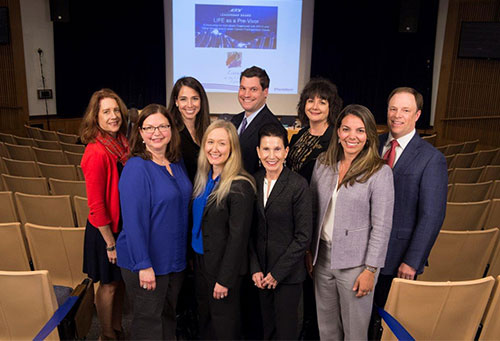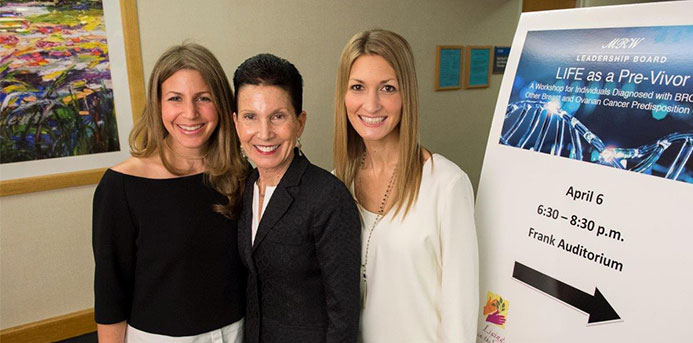Four years ago, Angelina Jolie announced to the world that she had chosen preventive surgery as a strategy to reduce the significant risk of breast cancer she faced as a BRCA1 gene mutation carrier. Her courage in sharing her personal story brought about public awareness and open discussions surrounding genetic testing, personalized medicine, and options available to those carrying genes that predispose them to hereditary cancers, diseases and conditions.
Four years ago, Caryn Engle also learned that she carried the BRCA1 gene mutation and she has been no less courageous in sharing her personal story — one that inspired continued awareness and open discussions in the North Shore community. In fact, Engle’s story provided the impetus for a recent NorthShore University HealthSystem educational forum called LIFE as a Pre-Vivor Workshop.*
On April 6, a panel of eight NorthShore medical specialists provided a comprehensive overview of the latest medical options and prevention strategies available to women carrying predisposition genes for breast and ovarian cancer (e.g., BRCA1/2, CHEK2, ATM, etc.). The two-hour forum was recorded at Evanston Hospital’s Frank Auditorium and will serve as an enduring educational program for both patients and physicians.

The panel presented material on five key areas of cancer risk reduction: genetic testing, screening, chemical prevention, surgical strategies and lifestyle modifications.
Identifying Individuals at Risk Through Genetic Testing
The initial step in identifying individuals at risk for breast and ovarian genetic contribution begins with a detailed family history assessment. Positive findings may indicate the potential for genetic factors that confer moderate or high risk of disease. Genetic testing can then be performed to determine true risk.
If predisposition genes are detected, a personalized health plan is developed to limit risk through care management options that include increased cancer screening, lifestyle modifications, and chemical/surgical prevention.
Medical geneticist Dr. Peter Hulick emphasized, “Genetics is not destiny — it’s not a guarantee that something will develop nor a diagnosis of cancer. But, it allows us to put a framework around, ‘How do we best manage care?’”
Family History Assessment From Panelist Anna Newlin’s Presentation
*Maternal and Paternal
- Cancer in two or more individuals on the same side of the family
- Cancer diagnoses in individuals less than 50 years of age
- Multiple primary tumors
- Bilateral or multiple rare cancers
- Cancer patterns suggestive of a specific cancer syndrome
- Evidence of autosomal dominant transmission
- Ashkenazi Jewish ancestry or ancestry from geographically isolated areas
High-Risk Cancer Screening (BRCA1 & BRCA2 Carriers)
The use of complementary screening modalities is key to risk reduction.
Breast: Guidelines for screening women over the age of 25 include monthly self-breast exams, clinical breast exams by a healthcare provider every six to 12 months, and an annual mammogram or MRI. Women over 30 years of age should be screened by mammogram and MRI each year.
Ovarian: Transvaginal pelvic ultrasound and the CA-125 blood test are both used in ovarian cancer screening, but their effectiveness has not yet been proven. Additional research is needed to discover screening tools with a greater reliability for early ovarian cancer detection.

New Technology: The Automated Breast Ultrasound System (ABUS) has emerged in the field of diagnostic radiology as a new potential screening device for women with dense breast tissue. Although the mammogram still remains the gold standard for early detection in most cases, women with dense breasts may be candidates for ABUS screening and should explore this option with their physician.
Chemical Prevention to Reduce Breast Cancer Risk
Chemical prevention (sometimes termed chemo-prevention) refers to medications that manipulate a woman’s hormone levels in order to decrease her risk for breast cancer. Tamoxifen, the most commonly prescribed drug for pre-menopausal women, has been shown to reduce estrogen receptor positive breast cancers by 40-86 percent. Because it decreases estrogen levels in the body, Tamoxifen chemically induces menopause, and as a result, side effects include menopausal symptoms.
High-Risk Surgical Strategies (BRCA1 & BRCA2)
Breast Removal and Reconstruction: Individuals with a BRCA gene mutation may elect to undergo prophylactic bilateral mastectomy as it decreases risk by more than 90 percent. It’s the most effective strategy for breast cancer risk reduction to date. However, mastectomies and breast reconstruction are not without their own risks and can require fairly extensive recovery time, cause permanent loss of chest sensation, and sometimes result in the need for additional surgery. Therefore, each individual must fully explore their options and analyze the benefit-risk ratio with their medical team.
Ovarian: Due to the current lack of reliable early detection screening tools, risk-reducing bilateral salpingo-oophorectomy (RRBSO) surgery is the most effective way to decrease ovarian cancer risk. If performed prior to menopause, it reduces the risk of ovarian cancer by 96-98 percent and breast cancer by 50 percent. The side effects and complications of RRBSO are typically much less than those experienced after mastectomy and breast reconstruction. However, removal of the ovaries causes immediate menopause, which may adversely affect cardiovascular health, bone density, and sexual and neurological function. Again, each individual is strongly encouraged to weigh their options and benefit-risk ratio with their medical team.
Lifestyle Modifications to Decrease Overall Cancer Risk
Individuals can reduce their cancer risk by adopting health-enhancing lifestyle modifications:
- Make healthy food choices (e.g., plant-based diet, Mediterranean diet, limit processed foods)
- Maintain your ideal weight (estrogen is secreted in fatty tissues)
- Exercise regularly (moderate activity 30 minutes per day or 2 1/2 to 4 hours per week)
- Limit alcohol consumption (1 drink per day increases post-menopausal cancer risk by 11 percent)
- Avoid exogenous estrogen hormone replacement
- Adhere to recommended cancer screening guidelines
Empowering Individuals Through Education
The aim of the LIFE as a Pre-Vivor Workshop* and video is to empower individuals through education. As Barb Guido, APN, CNP (nurse practitioner at NorthShore’s High Risk Breast Program) stressed, “[Our goal is to] empower women to learn what their risk is so that they can be proactive and do what’s right for them … No one option is necessarily right for every woman. My job is to educate and talk through your options with you so that you can make the decision that’s right for you.”
NorthShore Expert Panel
- Barbara Guido, APN, CNP, High Risk Breast Program, Nurse Practitioner
- Michael Howard, MD, Plastic & Reconstructive Surgeon
- Peter Hulick, MD, Division Head, Center of Medical Genetics, Medical Geneticist
- Elena Moore, MD, Gynecologic Oncologist
- Anna Newlin, MS, CGC, Genetics Counselor
- Catherine Pesce, MD, Director, Surgical Breast Program, Surgical Oncologist
- Georgia Spear, MD, Diagnostic Radiologist
- Elaine Wade, MD, Medical Oncologist
- Carol Rosenberg, MD, Director, LIFE Program; Cancer Survivorship Expert (Moderator)
*The LIFE as a Pre-Vivor Workshop and video were funded by the MRW Leadership Board, a charitable foundation committed to empowerment through education to enable informed decisions about hereditary breast and ovarian cancer prevention. (Co-Chairs: Caryn Engle, Ari Goldsmith, Stephanie Goldstein and Jordan Goldstein, MD.) For questions or more information about the Workshop or video, contact the LIFE Program at 847-926-5818.
The MRW Leadership Board is an extension of the Myra Rubenstein Weis Health Resource Benefit Committee that supports NorthShore wellness and cancer survivorship programs. Both were established to honor Myra Rubenstein Weis and her service to the Highland Park community.
More from Make It Better:

